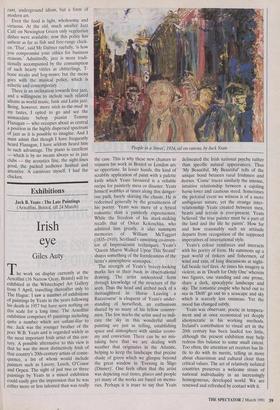Jazz
High dive
Martin Gayford
Jazz seems to be booming, and as it booms, so jazz clubs proliferate. As some- one who has spent many of the happiest evenings of his life in such places (as well, admittedly, as some of the most miserable) I naturally welcome this. And I was espe- cially pleased by the advent of the new Jazz Café on Parkway in Camden lak autumn; it is the biggest and most enterprising jazz venue to open in London in decades. In the last few months it has presented, among much else, numbers of specially imported American luminaries, some of whom haven't been seen over here for a consider- able while. I take my hat off to Mr John Dabner, the proprietor of the venture, and wish him well. I also note that his creation is an interesting departure from the classic tradition.
The original jazz rooms appeared in New York in the Thirties, many of them situated on a block or so of West 52nd Street. Descended from such colourful ancestors as Mahogany Hall, the New Orleans bor- dello run by Miss Lulu White, and sundry other jazz-featuring speak-easies, joints and dives, these early clubs were romanti- cally raffish in mood. We see an idealised version of them in the tenebrous, smoke- wreathed photographs of Herman Leonard. The 52nd Street clubs were indeed dark and smoky and also, apparent- ly, smelly, crowded and minute.
There is a solitary survivor of that era — the Village Vanguard in Greenwich Village: a small, irregularly shaped cellar whose spartan decor seems unaltered since at least the 1950s. Its owner, the late Max Gordon, when asked why a certain piece of carpet had not been renewed in 50 years, replied, 'If something's right, why change it?' As far as I am concerned, the Van- guard is just about perfect.
It is to this tradition that the older London clubs adhere. Ronnie Scott's, the first and still the most famous, was directly inspired by the Three Deuces on 52nd Street which Scott visited in the late Forties. Impressed by the music, the set-up and the flamboyant, peak-hatted doorman, Scott returned to England with the notion of founding something similar. The present Ronnie Scott's Club, relocated and fitted out in the 1960s, is a great deal plusher than 52nd Street ever was; and it has grown so famous that it probably matches or exceeds the 52nd Street crowds.
The Pizza Express on Dean Street in Soho is a hybrid between the American jazz club and another exotic post-war importation — the pizzeria. But it is close to the Manhattan originals in being tiny and underground. Personally I love its informality and intimacy, as well as the mainstream/bebop musicians it favours. Also subterranean, austere and of the old school are the 100 Club, Oxford Street, and the Bass Clef, just north of the City. The designery, all-black Pizza on the Park on Hyde Park Corner, though in a basement, is really a derivative of the jazz spot's rich relation, the supper club.
As against all these, the new Jazz Café is quite different in mood. It's a New Age place for New Age people. Not just above ground but positively airy, with two storeys, sparkling white paintwork and overhead gantrys, it resembles more an ocean liner or the Guggenheim Museum than a low- down dive. Architecturally, its message is clear: Jazz, it seems to say, is not an aber- 'You wait ages for Godot, then three come along at once.' rant, underground idiom, but a form of modern art.
Even the food is light, wholesome and virtuous. At the old, much smaller Jazz Café on Newington Green only vegetarian dishes were available; now this policy has unbent as far as fish and free-range chick- en. 'That', said Mr Dabner ruefully, 'is how you compromise your ethics for business reasons.' Admittedly, jazz is more tradi- tionally accompanied by the consumption of such hearty vittles as chitterlings, T- bone steaks and hog-maws; but the menu goes with the musical policy, which is eclectic and contemporary. There is an inclination towards free jazz, and a willingness to include such related Idioms as world music, funk and Latin jazz. Being, however, more stick-in-the-mud in my tastes, I opted to go and see the immaculate bebop pianist Tommy Flanagan — who occupies about as central a position in the highly dispersed spectrum of jazz as it is possible to imagine. And I must admit that though I have frequently heard Flanagan, I have seldom heard him to such advantage. The piano is excellent — which is by no means always so in jazz clubs — the acoustics fine, the sight-lines good, the packed audience hushed and attentive. A carnivore myself, I had the chicken.



















































 Previous page
Previous page